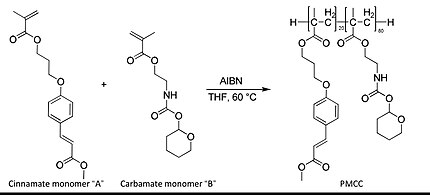Draft:PMCC polymer
 | Review waiting, please be patient.
This may take 3 months or more, since drafts are reviewed in no specific order. There are 2,386 pending submissions waiting for review.
Where to get help
How to improve a draft
You can also browse Wikipedia:Featured articles and Wikipedia:Good articles to find examples of Wikipedia's best writing on topics similar to your proposed article. Improving your odds of a speedy review To improve your odds of a faster review, tag your draft with relevant WikiProject tags using the button below. This will let reviewers know a new draft has been submitted in their area of interest. For instance, if you wrote about a female astronomer, you would want to add the Biography, Astronomy, and Women scientists tags. Editor resources
Reviewer tools
|
| Submission declined on 12 April 2024 by Stuartyeates (talk). Needs a much clearer explanation of what this is. Lead appears to be conflicted over whether this is artificial or natural. Also the relationship to acrylic. Pretend you're explaining it to an liberal arts undergrad.
Where to get help
How to improve a draft
You can also browse Wikipedia:Featured articles and Wikipedia:Good articles to find examples of Wikipedia's best writing on topics similar to your proposed article. Improving your odds of a speedy review To improve your odds of a faster review, tag your draft with relevant WikiProject tags using the button below. This will let reviewers know a new draft has been submitted in their area of interest. For instance, if you wrote about a female astronomer, you would want to add the Biography, Astronomy, and Women scientists tags. Editor resources
This draft has been resubmitted and is currently awaiting re-review. |  |
Poly ((tetrahydropyran-2-yl N-(2 methacryloxyethyl) carbamate)-b-(methyl 4-(3-methacryloyloxypropoxy) cinnamate))
Poly ((tetrahydropyran-2-yl N-(2 methacryloxyethyl) carbamate)-b-(methyl 4-(3-methacryloyloxypropoxy) cinnamate)) (PMCC) is a synthetic polymer with thermally active groups, which upon heating, decomposes and exposes primary amines, providing a basis for surface modification. The structure of PMCC is based on a PMMA backbone with different functional groups on its sidechain. It is soluble in cyclohexanone or chloroform and has been used to create bone tissue replicas and to study protein immobilization in biological sciences.[1][2][3]

Structure and synthesis
PMCC is a cinnamate-carbamate copolymer synthesized by a mixture of methacrylate monomers, a cinnamate monomer ("A", methyl 4-(3-methacryloyloxypropoxy) cinnamate) and a carbamate monomer ("B", tetrahydropyran-2-yl N-(2-methacryloxyethyl) carbamate). Polymerization of the two synthesized monomers is carried out through a radical polymerization using azobisisobutrylnitrile (ABIN) in tetrahydropyran (THP) with the temperature of 60℃.

Chemical properties
Pyrolysis
PMCC possesses two distinct decomposition/deprotection temperatures (Td). One starts around 150°C and accounts for 80% of the mass loss, and the second starts around 210°C that accounts for the last 20%. When decomposition temperature is 150-180°C, the carbamate monomer "B" of PMCC tends to decompose to carbon dioxide, 3,4-Dihydro-2H-pyran and polymer with primary amine groups.

Applications
PMCC is used mainly as a functional layer for grafting chemicals on substrates in nanoscale chemical patterning together with thermochemical scanning probe lithography (tc-SPL) which involves the use of a heated nanoscale tip to thermally deprotect amine groups on the PMCC polymer surface. Patterning resolution with tc-SPL on PMCC as small as sub-10 nm, with depths as small as sub-2nm and at speeds up to millimeters per second have been reported.[3][4] After the deprotection of the PMCC, the chemical function of the pattern is achieved by attaching various nano-objects to exposed amine groups.[5]
Liu et al. demonstrated the ability to create complex patterns with different functionalities by using PMCC and tc-SPL technology, including the electrostatic immobilization of negatively charged sulfonated enzymes at positively charged amine patterns.[6] These capabilities have significant implications for nanobiotechnology, as they could be used for the development of protein chips, and in studies of nanoelectronics fabrications.
